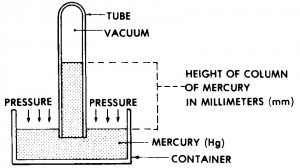Blood pressure refers to the force (pressure) with which the blood presses against the walls of the blood vessel.
All blood vessels–large or small, artery or vein–have blood pressure. However, the term blood pressure normally refers to the blood pressure of a major artery.
Unlike the other vital signs discussed previously, it takes two numbers–the systolic pressure and the diastolic pressure–to describe this vital sign.
Blood pressure is normally measured in millimeters of mercury (mm Hg). “Millimeters of mercury” is a standard unit for measuring pressure. It refers to how high a force (pressure) would cause a column of mercury (chemical symbol Hg) to rise in a tube.
Figure 5-1 gives the general idea. The greater the pressure, the more mercury is forced up the tube.

